
Author: site admin
Book Review: Wondrak and Other Stories by Stefan Zweig, Translated by Anthea Bell
Pushkin Press issues a set of psychologically intense anti-war stories by a now neglected early 20th century Austrian author.
Some literature — Shakespeare, Dickinson, Faulkner — feels timeless, as if retrofitted with a few new surface details it could have been written yesterday and not decades or centuries ago. Wondrak and Other Stories, by the early 20th century Austrian writer Stefan Zweig, is of another sort: though it deals with eternal themes — war and peace, the state vs. the individual — it reads, today, as if blanketed in a layer of naiveté.
By that I don't mean ignorance of the world; quite the opposite. It is an un-modern lack of irony that marks these stories as unlike those of most modern writers. In "In the Snow" ("Im Schnee"), the brief first story in this collection of three, the very youthful Zweig, a non-observant Jew, tells of a group of medieval Jewish families who flee their village ahead of what would centuries later be called a pogrom. But these Jews are not well-rounded characters; rather they are almost symbolically simple avatars of persecution and gloom. Even singing a celebratory Chanukah song, "the singing echoes like a hopeless lament, and is blown away on the wind." Even before we learn their fate, Zweig has let us know that for these Jews there can be no redemption – not even, it seems, in their own hearts.
"In the Snow" is a very early work; the mature Zweig was capable of much more nuance. Even so, "Compulsion" ("Der Zwang"), the long story at the center of the collection, has a discomfiting up-front quality, as if we're being compelled to press our faces against the glass and experience the story literally rather than reclining to watch the show in comfort.
Ferdinand, a peace-loving artist, has fled to Switzerland with his wife Paula to avoid being drafted into the German army during World War I. Nonetheless he receives a summons to service. Though he and Paula have agreed to take a principled, intellectually rigorous stand against any such conscription, in the event he feels compelled to answer the call, much as he wants to resist. It is an almost Jamesian tale of complex psychology, not just ideas.
This was an order that would not be denied. Somehow he felt himself wavering; that unknown sensation was back. His hands began to shake. His strength faded. Cold came from somewhere, like a draught of wind blowing around him, uneasiness returned, inside him the steel clockwork of the alien will began to stir, tensing all his nerves and making its way to his joints. Instinctively he looked at his watch.
Like Hans Castorp at the end of The Magic Mountain, Ferdinand's fate is left uncertain, though we are given room to hope for both his physical and his mental survival. The final tale lacks certainty for another reason: Zweig never finished it. Wondrak is titled after a minor character, a local functionary charged with assisting the authorities in locating young men avoiding the draft. The story recounts the life of a disfigured woman, Ruzena, who is now trying to hide her only son, Karel.
It's a tale of large cruelties and small mercies. Zweig left it off with Ruzena and her son both jailed, awaiting his transport off to war. Knut Beck, an earlier editor of Zweig, suggested that perhaps the author felt the story couldn't have been published because of its subject matter and therefore didn't finish it. I think it's just as likely that he quit because he'd written himself into a corner. Either way, again there is no irony; though certain characters may have psychological depth, what actually occurs is plainly motivated and sensible, at least within the twisted sensibility of war. We do, however, wish we knew what became of Ruzena, having dwelt with her for some 33 pages.
I suspect Pushkin Press's earlier Zweig release, Amok & Other Stories, might be a better introduction to the author. But this volume has piqued my interest in reading more from a writer who was one of the most successful of his time but is largely unknown today in the English-speaking world. I was a little disappointed to spot several typos, after finding the same publisher's edition of Shakespeare's Sonnets such a model of small-print perfection. But Pushkin's unique and rather artistic small softcover format remains appealing.
Music Review: Indie Round-Up – Mosher, Cleaves, Terry
Manda Mosher, Everything You Need
Manda Mosher's airy but sultry alto is a refreshing change from the little-girl voices that dominate pop music, and crop up a lot in today's rootsy music too. Mosher's sun-baked pop-rock doesn't fall easily into a genre either, though decades ago we could safely have simply called it "rock."
Mosher's dobro plucking and Dylanesque harmonica playing nod to the front porch, but her songs, especially in these keyboard-heavy arrangements, hark back more to 1970s arena rock (especially Tom Petty and the Heartbreakers) than to anything current. The sole cover, however, is a lovely acoustic rendition of Pete Townshend's sweet, slightly precious "Blue, Red, and Grey."
Though reasonably well-crafted, Mosher's songs are a little pallid, lacking in excitement. As if trying to make up for this, producer Guy Erez has overproduced the tracks, and they are recorded on the CD crazily loud. These choices don't serve Mosher's subtle vocals well. She's not a brash Kelly Clarkson or a squeaky Taylor Swift, she's more of a smoky Christine McVie or Joni Mitchell. But this CD tries to hit you over the head with her. I suspect I'd enjoy her music more if it were in a more intimate setting.
Slaid Cleaves, Everything You Love Will Be Taken Away
Slaid Cleaves is one of those consummate songwriters whose stuff would sound great coming from almost any singer you can think of. But like Kim Richey (of whom he reminds me), his own voice, though not a powerhouse instrument, wraps perfectly around his words and melodies.
Cleaves' first new CD of original material in five years is the kind of album it's hard to write about because the music doesn't invite much analysis. It's like trying to grab hold of an object so smooth and frictionless you can't get a grip on it. Gurf Morlix, one of Americana music's great unsung producers, keeps things spare and simple, as befits the literate but straight-arrow songs.
Cleaves' stories and vignettes range from workingman's plaints, like "Tumbleweed Stew" and the Springsteen-esque "Hard to Believe," to grim ditties of war and death like "Green Mountains and Me" and the relentless, Townes-sad "Twistin'." Although there's a lot of negative imagery in the lyrics, the music has an unprepossessing, almost dancing quality even when it's slow. This makes you lean into the lyrics to see the vivid pictures. Good-looking music, this.
Jesse Terry, The Runner
Here's an expertly crafted, beautifully produced CD of poppy country-rock from a singer-songwriter with an open, engaging, emotionally powerful voice and a knack for melodies. But the lyrics take it down a peg. Cliches and sentimental storytelling are OK in songs up to a point, of course, but only if they're put together in original ways, or if they sit perfectly with the melodies in that indescribable, magical way that turns a competent song into a really good one.
These lyrics too often disappoint in that sense, even edging into cheesiness at times, as with the title track. In other songs, like "Edges" and "Ghost Town," good setups with well-conceived tunes and imagery don't lead to strong musical payoffs.
Where Terry does connect, for me, is in his acoustic ballads, where rather than forcing his way to attempted big choruses, he seems to be simply saying what he wants to say. "Noise," "A Refuge," and the exquisite "Africa" flow with complete naturalness, like songs by the Beatles, Don Henley, or Kevin So.
Theater Review (NYC): Rock of Ages
80’s hair bands get the Broadway treatment in an evening of pure escapist fun.
'80s rock, with its hair bands, codpieced lead singers, and rainbow-bright guitar heroes, was all about excess and pomp. It was hard to take seriously then; today it's experienced as gaudy kitsch. But as with all genres of pop music, catchy songs were what made bands like Journey, Poison, and Night Ranger popular in the first place, so these bands are as ripe for the Broadway treatment as popsters of any other era.
After successful runs in Los Angeles and off-Broadway, Rock of Ages has crash-landed at the Brooks Atkinson — noisy, flashy, and most of all, funny. The creators of the show smartly decided to play it entirely for laughs, and the result is an evening of pure escapist fun, exactly what a city weary of bad news needs.
The book, by Chris D'Arienzo, tells a story so self-consciously cliched it can't help bursting out of its boy-meets-girl envelope and turning on itself with in-jokes and outrageous mugging. Mitchell Jarvis, in a Jack Black-like turn, plays Lonny, a sound man at a rock club on the Sunset Strip who also functions as the narrator. 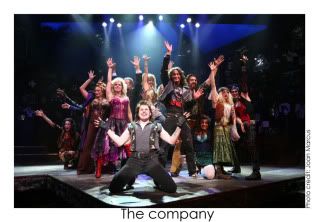 "I wanted to explore deep and thoughtful theater," he complains late in the proceedings, but instead was hired for a show with "poop jokes and Whitesnake songs."
"I wanted to explore deep and thoughtful theater," he complains late in the proceedings, but instead was hired for a show with "poop jokes and Whitesnake songs."
When aspiring rock star Drew (Constantine Maroulis), the taller, masculine member of the show's star-crossed pair, denies having referred to ingenue Sherrie (Amy Spanger) as a mere "friend," Lonny pops out of a side doorway to remind him, "Actually, you did." The show is loaded with self-reference and toilet humor; there's really nothing going on beneath the music and dancing and horsing around. But the action and the fun never stop, and they're all we need. This show is pure visceral experience. What it's about is the music.
The cast sings extremely well, and the band is kickass. This was undoubtedly the first and only time I'll ever actually enjoy hearing Poison's "Every Rose Has Its Thorn." 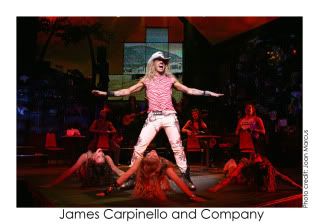 Never has REO Speedwagon's "Can't Fight This Feeling" been so perfectly apropos as here, dramatizing a new-found gay love. Vocally, the show's finest musical moment is a duet by Drew and Sherrie of Damn Yankees' "Can You Take Me High Enough."
Never has REO Speedwagon's "Can't Fight This Feeling" been so perfectly apropos as here, dramatizing a new-found gay love. Vocally, the show's finest musical moment is a duet by Drew and Sherrie of Damn Yankees' "Can You Take Me High Enough."
But the biggest applause was for a showstopping number built around Pat Benatar's "Hit Me With Your Best Shot," sung by Wesley Taylor as Franz. Franz is the flouncy son of a German developer who wants to replace the Strip's trashy but vibrant clubs with sterile strip malls. Defying his humorless, fun-crushing dad, Franz represents — nothing, actually, except a breakout role for the delightful Mr. Taylor. There's no depth here. It is what it is: surface sheen, happy noise, and songs with pounding hooks that you just can't get out of your head. Need a break from it all? Hop in your Speedwagon and Journey across the river Styx to 47th Street.
Rock of Ages plays until the final countdown at the Brooks Atkinson Theatre, 256 W. 47 St., NYC.
Theater Review (NYC): Macbeth
Patrick Stewart is a tough act to follow, but Hipgnosis isn't afraid: they've plunged into the roughened seas of the Lower East Side with one of New York's first Macbeths since Rupert Goold brought Mr. Stewart and Kate Fleetwood to our fair city for a brief reign of terror, first at the Brooklyn Academy of Music and then on Broadway.
This is also probably the first Manhattan Macbeth since another foul, bloody reign ended and a new, unusually dark-skinned thane became the hopeful leader of a violent nation. This color-neutral Macbeth, with the great Julian Rozzell in the title role, seems especially appropriate today. We tend to think of the play as being about lust for and corruption of power, about tyranny, cruelty and comeuppance, but this production seems to stress the fate of Scotland as much as it does those of its individual characters.
"I think our country sinks beneath the yoke," cries Malcolm as he and Macduff hatch their plan to take down the freshly minted tyrant; "It weeps, it bleeds; and each new day a gash / Is added to her wounds." The two vengeful warriors shout through this crucial scene — too much so — as if to pound home the message that their mission is infinitely larger than themselves.
A good Macbeth must have, at minimum, a good Macbeth. The Hipgnosis team has tapped Mr. Rozzell, a founding member of the group and an actor of great range, magnetism, and subtlety. Lanky and sinewy, he prowls and arches over the stage, which is actually a brightly lit pit like a wrestling ring.  As Macbeth battles conscience and guilt, sometimes reduced to crawling like a bug on the scuffed and bloodied white floor, the lights never dim. It's meant to suggest the broad-daylight productions of Shakespeare's time, with all atmosphere and suspense generated purely by the words and action.
As Macbeth battles conscience and guilt, sometimes reduced to crawling like a bug on the scuffed and bloodied white floor, the lights never dim. It's meant to suggest the broad-daylight productions of Shakespeare's time, with all atmosphere and suspense generated purely by the words and action.
Mostly, it works. The able cast is co-anchored by Elizabeth Mirarchi as a diminutive, highly focused Lady Macbeth and Richard Ugino as Banquo, both Hipgnosis regulars who shone in very different lights in The Caucasian Chalk Circle last year. Under John Castro's straightforward direction the characters march simply from scene to scene, stolidly pushing Shakespeare's inexorable story towards its fated conclusion.
The gauzy witches are a little scary and a little funny, their white wrappings vaguely resembling the nurses' outfits of the Stewart production; the banquet scene with Banquo's ghost is played partially (and I think intentionally) for laughs, a choice which ironically pays off by deepening our feeling for Macbeth's pain. Only occasionally, as in the build-up to Macbeth's downfall, when scenes fly by in quick succession, does the lack of scenery and lighting seem to strand the actors in an uncomfortable, Beckettian limbo.
This production can't help but labor in the shadow of its titanic predecessor. But, avoiding any temptation to bend Shakespeare out of shape for the sake of originality, the Hipgnosis group has realized a stirring, straight-up Macbeth. Mr. Rozzell's performance, with its youthful, blazing, and animalistic intensity, alone makes this production worth seeing, and there's a good deal more as well.
Macbeth runs through April 19th at the Flamboyan Theatre, Clemente Soto Vélez Cultural and Educational Center, 107 Suffolk St., NYC. Tickets at Smarttix or call 212-868-4444. Photo courtesy of David Gibbs/DARR Publicity.
Theater Review: Mrs. Warren’s Profession by George Bernard Shaw
It’s a testament to both Shaw’s brilliance, and to the slow, fitful progress of societal change, that this play still feels pretty current.
Written in 1893, Mrs. Warren's Profession wasn't publicly staged in England until over 30 years later. Its frank (though euphemistically phrased) treatment of prostitution was the obvious reason for the play's suppression, but its truly modern subject was the newly developing role and rights of working women. It's a testament to both Shaw's brilliance, and to the slow, fitful progress of societal change, that the play still feels pretty current.
The present production by BOO-Arts at Manhattan Theatre Source does very well by Shaw. Director Kathleen O'Neill, founder and director of the company, creates a pleasing, almost earthy sense of intimacy by placing the audience on two sides of the action. Shaw's dialogue is supremely fluent and expertly whittled, but also somewhat heightened; staging the play so that we're practically embracing the cast pulls a modern American audience into the action and helps make everything seem quite natural. Ms. O'Neill has grasped both the essential characteristics and the depths of Shaw's characters: not only the pivots of the story — the middle-aged madam of the title and her independent-minded daughter Vivie — but the four class-conscious men orbiting the women.
All the roles are very well cast, though some of the British accents are more successful than others; the excellent James Dutton, who plays Vivie's young, ne'er-do-well boyfriend/boy toy, has an advantage here, being British-born. His lounging, lunging, cynical Frank Gardner is like a prancing Wodehouse fop made suddenly self-aware. Broadway veteran Joy Franz is a magnificent Mrs. Warren, commanding the stage, revealing her history to her daughter with power and grace and pathos.  Ashton Crosby is a delightfully humorous Rev. Gardner. Joseph Francini is an effective Praed, the aesthete of the group, and David Palmer Brown has a grand time with the meatier role of Sir George Crofts, who initially appears to be a cad and blowhard but turns out to be rather more, and less.
Ashton Crosby is a delightfully humorous Rev. Gardner. Joseph Francini is an effective Praed, the aesthete of the group, and David Palmer Brown has a grand time with the meatier role of Sir George Crofts, who initially appears to be a cad and blowhard but turns out to be rather more, and less.
Caralyn Kozlowski is a wonder as Vivie, completely disappearing into her complex character, biting down on emotions, then opening up just enough for us to read her precisely, controlling herself and controlling the men with the only real power she has: her determination. She makes us laugh even as she faces the serious conundrum of woman's lot.
Including intermission, the play runs two and a half hours, but it zips by. It's actually one of Shaw's shorter plays, and as such it's done more often than some; still, this is a fairly unusual opportunity to see a top-notch staging with an excellent cast in an intimate setting. Mrs. Warren's Profession runs through April 18 at Manhattan Theatre Source.
Book Review: The Midwife by Jennifer Worth
For every episode of fascinating but technical medical reporting (I learned a lot about birthin' babies from this book), there's a recollection or reflection that achieves a kind of literary transcendence.
London's East End, the 1950s, winter. A thick yellow smog keeps the local doctors busy treating respiratory problems; elderly folks die by the hundreds. But Conchita Warren, pregnant for the 25th (yes, the 25th) time, has suffered a fall and gone into labor two months early.
The young midwife who has been providing Conchita's prenatal care receives the late-night call, and bicycles through the soupy cloud of pollution to tend to her charge. Jenny is an experienced midwife by now, but has never had to deal with a premature birth. The mother is very sick; the baby is born successfully, tiny but alive. Finally doctors arrive and order the baby transferred to hospital, but Conchita won't let go of the minute infant. No amount of pressure can pry her hand off it, and her husband, Len, takes her side.
This is but one of many dramatic episodes ("adventures" wouldn't be an inaccurate term) recounted by Jennifer Worth in her absorbing, eye-opening, wise, touching, and sometimes suspenseful memoir of life as a nurse-midwife in the poor parts of London in the postwar years. Times were tough and crime always threatened, but unlike policemen, who patrolled in pairs for "mutual protection… we nurses and midwives are always alone, on foot or bicycle. We would never be touched. So deep is the respect, the reverence, of the roughest, toughest docker for the district midwives that we can go anywhere alone, day or night, without fear."
And they had to. Jenny visits bombed-out buildings, condemned many years before but still inhabited by the dirt-poor. She encounters women who've been abused by husbands, by pimps, and by the infamous workhouses, and ravaged by illnesses ranging from rickets to eclampsia. Yet moments of amazing grace shed a different light on the human condition: a first-time father has an unexpected reaction to his new baby's suspiciously dark skin; a young boy befriends a clumsy, socially inept midwife, gallantly defending her against ridicule; Jennifer discerns the startling secret to Conchita and Len's everlasting, unconditional love. And as the young agnostic grows to respect the nuns who run the midwives' practice, she inches towards a religious revelation.
Ms. Worth's prose is only workmanlike, but all her stories are interesting, and for every episode of fascinating but technical medical reporting (I learned a lot about birthin' babies from this book), there's a recollection or reflection that achieves a kind of literary transcendence. Of Mrs. Jenkins, a ragged old woman who magically appears in the street wherever a birth is about to occur, Ms. Worth writes:
She stepped over the edge of the big tin bath and sat down in the water with delight, splashing and giggling like a little girl. She picked up the flannel and sucked the water noisily, looking up at me with smiling eyes. The room was warm because I had stoked up the fire, and a cat strolled up and looked curiously over the edge of the bath. She splashed him in the face with a giggle, and he retreated, offended. The front door banged, and she looked up sharply. "Rosie, that you? Come 'ere, girl, an' look a' yer ol' mum. It's a rare sight."
But the footsteps went upstairs, and Rosie didn't come.
The nuns themselves are among the most interesting characters: ancient crazy-like-a-fox Sister Monica Joan; bustling, foul-mouthed Sister Evangelina; saintly Sister Julienne. Worth's exact recounting of dialogue, and her detailed descriptions of scenes that were only told to her by others (and decades ago at that), feel suspiciously detailed. But if she has recreated, it all feels apt; everything in this book is vividly believable, and often gripping. Even the appendix on cockney dialect was no exception; I began to read it dutifully but finished it wishing for more. It will surely be appreciated by any American who's tried to fight through an episode of Eastenders.
A great success in England, this book deserves just as much appreciation on the west side of the pond. Jennifer Worth's tales of a half century ago lose nothing with transplantation to modern times; society really hasn't changed all that much. And they will resonate with anyone who ever had a heart.
Theater Review: Miss Evers’ Boys
David Feldshuh’s dramatization of the infamous Tuskegee Experiment receives a dazzling revival in a tiny New York theater.
David Feldshuh's Miss Evers' Boys has been around for 17 years, most notably in its 1997 Emmy-winning TV adaptation. But in the current production by the Red Fern Theatre Company it still feels as fresh as a spring rain.
The dazzling cast has something to do with this. Their superb performances, under the more than able direction of Melanie Moyer Williams, flesh out the disturbing story that Mr. Feldshuh's script tells so achingly.
Beginning in 1932, a government program which became known as the infamous Tuskegee experiment subjected a group of syphilitic African-American men in Alabama to a cruel study. Told they were being treated for their "bad blood," they were in fact denied treatment. The crude medicines of the time — and later, more egregiously, the lifesaving new drug penicillin — were withheld from the men, so doctors could study the ravages of the disease over time and determine whether blacks and whites were affected the same way.
Given this nightmarish scenario, with its numerous victims and its overtones of eugenics, the script is remarkably evenhanded. Feldshuh's central insight was to focus on the character of Eunice Evers, a selfless nurse who, believing she is doing her best for the men, wins their trust and cares for them through their years of illness and suffering. Framing the action, which takes place at the outset of the study and then fourteen years later, are snatches of Nurse Evers' testimony before Congress in 1972 when the whole horrid affair came to light.
Played with the utmost grace by Nedra McClyde, who was excellent in Victor Woo and TBA and gets a well-deserved central role here, Nurse Evers initially trusts the doctors running the study. She is so strongly animated by her calling that she never starts a family of her own; the men become her charges, and she comes to love them dearly. But as Nurse Evers loses faith and the anguish of her inner conflict grows, Ms. McClyde makes us feel both utter sorrow and powerful admiration for the character.
Though the racial attitudes depicted in the play are no longer dominant in our culture, the play remains vivid because its underlying themes are timeless. Conflicting loyalties and man's inhumanity to man never go out of style. 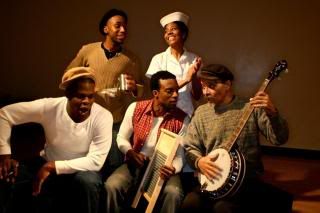 More specifically, evidence of our nation's painful racial history lingers everywhere. The play also has many old-fashioned virtues that have retained their effectiveness since the dawn of theater: lots of drama, painful scenes, funny ones, and colorful characters with complex personalities and distinct, sometimes exaggerated traits.
More specifically, evidence of our nation's painful racial history lingers everywhere. The play also has many old-fashioned virtues that have retained their effectiveness since the dawn of theater: lots of drama, painful scenes, funny ones, and colorful characters with complex personalities and distinct, sometimes exaggerated traits.
There's the sharp, mistrustful rebel, the high-spirited hoofer with dreams of stardom, the superstitious farmer quailing before the march of progress, and the illiterate elder with homespun wisdom. Played respectively by Garrett Lee Hendricks, Jason Donnell Bush, Marty Austin Lamar, and veteran David Pendleton, these men suffer separately and together through scenes of excruciating "treatment," joyful song and dance, agonizing decision-making, abnegation, struggle, and occasionally grace. They're a terrific ensemble, and each has beautifully-played individual scenes as well. The doctors too, both white and black, are, like Miss Evers, complicated people, dedicated professionals who believe they are doing right. They just can't see (in the case of the white doctor, played by Alex C. Ferrill), or overcome (in the case of the black doctor, played by the imposing Evander Duck), the twistedness of the situation in which they find themselves.
The stars seem to have aligned for this production: excellent actors perfectly cast, with a director who knows just how to seize on the strengths of Feldshuh's scenecraft. The show may be a little slow going at a few points and unnecessarily heavy on the pathos at the end, but the brilliant talent collected here has no trouble wiping the floor with these minor flaws. This Miss Evers' Boys is a triumph. It plays Thursdays through Sundays through April 5 at the Shell Theatre in the Times Square Arts Center, 300 W. 43 St. Tickets at Ovation Tix online or call 212-352-3101. A portion of the proceeds from this Red Fern Theatre Company production goes to benefit the Nordoff-Robbins Music Therapy Foundation. Photo by Nathan Johnson.
Ancient History
Theater Review: The Cambria by Donal O’Kelly
Frederick Douglass’s 1845 voyage to Ireland becomes a richly fictionalized tale of colorful figures and high drama at sea.
In 1845 Frederick Douglass, already a famed abolitionist though not yet 30, sailed for Europe aboard a ship called the Cambria. Fleeing hostile forces in the United States who were making his activities difficult (to say the least), he received a hero's welcome in Ireland from crowds of sympathetic, long-suffering Irish Catholics familiar with his career and his recently published autobiography.
Douglass spent six months in Ireland, finding there the morale boost he needed to continue his crusade. I spent an hour and a half at the Irish Arts Center in New York on St. Patrick's day, getting my first taste of Donal O'Kelly's work. The Cambria concerns not Douglass's time in Europe but the ocean voyage itself. He and director Raymond Keane bring it to life as a richly fictionalized tale of colorful figures and high drama at sea. Embodied by Mr. O'Kelly and Sorcha Fox — both superb actors — these people are by turns amusing, inspiring, and a little scary.
Some of the characters are more faceted than others. Mr. O'Kelly's Douglass, always calm and dignified, is (no pun intended) the least "colorful" of all, the quiet eye at the center of the storm. His power is all in his words, but they are all he needs, some written for him by the playwright, others taken directly from Douglass's own eloquent works. Yet he's not without complexity; sent down to steerage when his first-class neighbor complains about the proximity of a black man, he observes, without sore indignation, "I feel at home among the mishmash of nationalities."
More violent personalities dance around him. A lively abolitionist, given a pitch-perfect American accent by Ms. Fox, is insufferably righteous. Ms. Fox also depicts a delightful little girl who refuses to believe that her new friend "Mr. Johnson" (Douglass incognito) is not a minstrel. She also plays male characters with complete conviction.
The skipper, the rueful son of a slave ship captain, has an evocative and gloriously staged (if perhaps not quite earned) Act Two revelation. A Southern slaveholder, also played by Mr. O'Kelly, makes an effective villain; if I were ignorant of American history I'd accuse the playwright of creating a caricature, but alas, the plantation owner's blind paternalism and cruelty were all too endemic; his descent into seething animal hatred feels both comical and real on a level deeper than realism.
Mr. O'Kelly's language is worthy of the mantle of the great Irish dramatists of the past — warm, poetic, funny, pained, sprightly yet always faintly weighted, but never bitter. "Never been at sea? You must have been mighty contented with your life on land." "Imagine not knowing your birthday." "Beware the Quaker choir ladies."
This play provides one of those concentrated, magical experiences one hopes for every time one takes one's seat in a theater. The Cambria had a limited run through Sunday, March 22 at the Donaghy Theatre at the Irish Arts Center in New York City.
Theater Review: Tartuffe
Molière's Tartuffe is not one of those classic plays that need a lot of exegesis for the benefit of contemporary audiences. Though it dates from the 1660s, its vivid characters, uproarious humor, and theme of hypocrisy and scamming remain thoroughly understandable across the centuries. Nevertheless, many adaptations and "modernizations" that go beyond mere translation have been created and produced for English-speaking audiences, some in prose, some in rhyming verse like the original French. Richard Wilbur, Christopher Hampton, and many others have tried their hands.
Jeff Cohen's new rhyming-verse version is set in America during the Great Depression. His program notes relate this choice to the present economic crisis and in particular the breathtakingly audacious confidence men, like Bernie Madoff, who've had their part in it. I'd argue that Tartuffe's scheming is more akin to a different type of confidence game, that of the televangelists. Either way, though, the game is to separate a gull from his money (and/or position), not necessarily by lying to him, but always by taking advantage of one of his innate character traits, whether greed, insecurity, or something else.
Either way, too, Tartuffe is a play for our time, wherever and whenever one sets it, and Mr. Cohen understands this. His verse is primarily conversational, but it is elevated where it needs to be (as in some of Tartuffe's flowery outbursts, 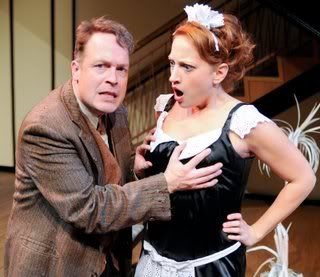 and the speeches of the prim, moralizing Cléante, mincingly portrayed by Brian Linden, who was so wickedly foppish in The Country Wife two years ago) — elevated, however, not into self-conscious poetics, but into the tones and rhythms of high comedy, especially American comedy, the line that runs from vaudeville through the great TV sitcoms of the 1950s.
and the speeches of the prim, moralizing Cléante, mincingly portrayed by Brian Linden, who was so wickedly foppish in The Country Wife two years ago) — elevated, however, not into self-conscious poetics, but into the tones and rhythms of high comedy, especially American comedy, the line that runs from vaudeville through the great TV sitcoms of the 1950s.
To "fund" his vision of the play, Mr. Cohen, who also directed, has at hand an embarrassment of riches in the form of a superb cast. The production's publicity stresses the presence of Christina DeCicco, who plays Elmire, the sexy young wife of Orgon, Tartuffe's central victim. Ms. DeCicco is indeed excellent: agile, beautiful, and delightfully funny, she even gets to show off her singing voice in one hilarious moment (she played Glinda in the national tour of Wicked and it's no wonder).
But she is matched by the two male leads, Keith Buterbaugh as Orgon and the rubber-faced Tom Ford in the title role, and by Deanna Henson as the fiery maid Dorine, who is actually the household glue. Ms. Henson's command of the speedy verbosity required of her by Mr. Cohen's gushing script and rapid pacing is most impressive. Mr. Ford's Tartuffe is truly demonic — he's the very model of duplicity, utterly qualm-free about his plot to take control of his mark's fortunes, and equally bald-faced in his lust for Elmire even as he gleefully looks forward to marrying Orgon's lisping daughter Marianne.
Katia Asche plays Marianne as a pretend-innocent with a flair for emotional manipulation — one comes to feel that in different circumstances, she'd make a good female Tartuffe-in-training, though unlike that master manipulator, she is capable of love. Her paramour, the mock-heroic Valère (Rob Maitner), is funny and even a little touching, riding to the rescue in his preppy sweater. Susan Jeffries is exquisite as the hapless family matriarch, and Mr. Buterbaugh portrays her son, Orgon, as so willfully blind to Tartuffe's maleficence that we gape in amused horror.  Ably representing righteous indignation is Aaron Costa Ganis as Orgon's wronged, stuttering son Damis, while Jasper Soffer makes a properly snooty Bailiff.
Ably representing righteous indignation is Aaron Costa Ganis as Orgon's wronged, stuttering son Damis, while Jasper Soffer makes a properly snooty Bailiff.
Mr. Cohen makes good use of the high, boxy space of @Seaport! with its big staircase; the effective, pastel set is by Alex Distler, while a couple of Anne E. Grosz's perfectly pitched period costumes are almost characters in themselves. Trying hard, I can squeeze out a small complaint about what seem to be references to Giuliani-Bloomberg era New York in the final scene with the Cop (Mark DeFrancis) — more concern for cops than the poor, etc. — but I'm reaching.
Speaking of cops and robbers, it's almost criminal that you only have to pay off-off-Broadway prices for the level of talent on display here. Go quickly, there are too few performances and not many seats at each.
Tartuffe runs through March 29 at @Seaport!, 210 Front St., across from South Street Seaport, NYC. Presented by Dog Run Rep. Tickets at Smarttix or call (212) 868-4444.
Photos by Erica Parise. 1) Tom Ford as Tartuffe and Deanna Henson as Dorine. 2) Christina DeCicco as Elmire and Keith Buterbaugh as Orgon.
Theater Review: Figaro/Figaro
This extended Figar-anza with music is an exercise in extremes and an interesting concept. Unfortunately, half is also an ordeal.
Two Figaros for one low off-off-Broadway price — sounds like a good deal, right? Playwright Eric Overmyer adapted and concatenated Beaumarchais' original Marriage of Figaro (the play on which the famous Mozart opera is based) and a rather dark 20th century sequel, Figaro Gets a Divorce, into one extended Figar-anza — with music. It's a long night, an exercise in extremes, and an interesting concept. Unfortunately, half is also an ordeal.
In the 1930s, the German-language playwright Ödön von Horváth wrote a time-transposed sequel to The Marriage of Figaro. In Figaro Gets a Divorce, the Count, the Countess, the steward Figaro, and his wife Susanna have fled a 20th century Communist revolution into an efficiently run, unnamed but Germanic-style neighboring country. While the fallen Count enters a downward spiral of gambling and depression, Figaro returns to barbering in a small town. But marital issues and conflicting ideals push the barber and Susanna apart, and she ends up alone, waitressing in a cafe.
Transporting Beaumarchais' colorful characters, who are more emblematic than realistic, into a modern, bourgeois, somber-hued world, exploring what happens to the fallen nobility, and examining how the various servant characters at home and abroad might retain or transfer their loyalties is an interesting idea. But either von Horváth's play is very bad, or it has been adapted very badly.
Knowing a bit of Eric Overmyer's work, and judging from the high quality of his adaptation of the Marriage, which forms the first act of this production, I suspect the fault to lie with von Horváth's original work. (I was not familiar with it prior to this production.) Once the characters are situated in their new universe and some parameters are established, the story, such as it is, flies every which way. Each scene seems a disconnected vignette, and we quickly cease to care about those once-lovable characters. The political philosophy that gets poured on doesn't make up for it; it's facile and not effectively dramatized. On top of all that, inexpertly played music and some goofy costume choices make a poorly conceived work seem poorly executed as well.
That's a pity, because, with nimble help from director Erin Smiley, Mr. Overmyer begins the evening with a clever, cheery, mostly well-played, compressed telling of the original late 18th century play, adorned with musical themes from Mozart's famous opera. The music comes from supporting cast members who double on an assortment of instruments, marching in and out, annoying the main characters — it's silly but quite funny.
More important, the leads are solid. Teddy Alvaro makes a witty and energetic (if a little too modern-ironic) Figaro, Ralph Petrarca a wry and funny Count Almaviva, and Kathryn Elisabeth Lawson a spry and winsome Cherubino. Gillian Wiggin's Susanna is especially delightful; in this telling she bears the greatest dramatic weight, along with her share of the comic, and does it wonderfully well. She alone makes the dreadful second half faintly bearable.
Fortunately, at off-off-Broadway prices, you will get your money's worth just from the first half. It's a minor tour de force of distilled, manic storytelling, expertly directed and nicely played. As for what Stephen King might call the evening's "dark half," enough said.
Through March 22 at the 14th Street Theater, 344 W. 14 St, NYC. Staged by the (re:) Directions Theatre Company. Tickets online or call (212) 868-4444.
Editing Test
Four Finger John
Free music!
Slowly but surely our new Whisperado CD project is progressing. This will be our first full-length recording, with a song count in the double digits! We’ll finish recording later this spring, and soon after that we’ll have a hot little product ready for download – and even available on old-fashioned plastic discs in break-y transparent jewel boxes!
But in the meantime, during a lull in the Whisperado recording process I went to Tom White’s studio in Schoharie County in upstate New York  and recorded three acoustic songs: a very tardy tribute to the late John Entwistle of the Who, a (seasonally speaking) very early Christmas song, and a folksy version of “Hand-Me-Down.” So it’s not really an album – more like an extended single, or a really short EP. Whatever you want to call it, it’s yours free – email me at music / at / whisperado / dot / com for the link to download the songs.
and recorded three acoustic songs: a very tardy tribute to the late John Entwistle of the Who, a (seasonally speaking) very early Christmas song, and a folksy version of “Hand-Me-Down.” So it’s not really an album – more like an extended single, or a really short EP. Whatever you want to call it, it’s yours free – email me at music / at / whisperado / dot / com for the link to download the songs.
Theater Review: The Question House
What if there were a house in which only questions could be spoken?
What if there were a house in which only questions could be spoken? Does that sound, well, Jewish? What if I told you that the premise is that Harvey Krytz (Howard Green) had a rabbinical vision some 40 years ago, and has operated out of these mystical quarters ever since? Wouldn't you agree that he might need young assistants?
But wouldn't it be hard for them to remember the questions-only rule, or to resist rebelling against it? And then wouldn't they then suffer an unpleasantly biblical fate?
Could it be that this show is pretty much just an extended comedy skit? Then again, if it's fresh, crisply paced, and doesn't overstay its welcome, what's wrong with an extended comedy skit? How could Mr. Green, along with Cam Kornman (who plays his long-suffering helper, Margaret), be anything but delightful? And could they ask for support more solid than that provided by the funny Nick DeSimone as an unfortunate job applicant, and the glorious Snezhana Chernova as a defiant aide?  (Is it disconcerting to see a character called "Miss Bingham" played by an actress with a Russian accent? Well, haven't you already figured out that this play is, after all, an exercise in absurdity?)
(Is it disconcerting to see a character called "Miss Bingham" played by an actress with a Russian accent? Well, haven't you already figured out that this play is, after all, an exercise in absurdity?)
Does Ms. Chernova have a fan club? If so, can I join?
When you get right down to it, isn't it all about the fun playwright Tara Dairman has with the constant tension (and the humor) engendered by her conceit? Who'll slip up? Who'll escape from the Question House? Will we? Will you?
Can you find time to see The Question House before the Frigid Festival ends on March 8? Will you believe me when I say that you'll have a fun time?
(I couldn't be the first reviewer of The Question House to review it "in kind," could I? Does it matter? In any case, how'm I doing?
Theater Review: The Hefner Monologues by John Hefner at the Frigid Festival
Embarrassing moments, funny situations, life-changing experiences, and revelations in the life of a young man with a very famous relative.
Every year I look forward to the Frigid Festival, and finally it's here.
That's a lie. In actuality, every year (this is their third) Frigid sneaks up on me, and all of a sudden there are all these interesting little productions happening all at once, and hardly any time to see them. Some are locally grown, but many are touring shows that drift about the continent, attempting to take root at whatever festivals they can get into. (A bit like bands, come to think of it). If I had no other responsibilities, I'd take the 12 days off and just hang around the East Village going from one Frigid show to the next.
John Hefner's The Hefner Monologues both is and isn't what you might guess from the title. Yes, it's monologues; no, they're not separate or independent. Yes, it's a guy named Hefner talking about his own life; no, his stories are neither fictionalized nor gaudily embellished (at least, he is able to convince us as much).
As personal tales are wont to, these include embarrassing moments, funny situations, life-changing experiences, revelations. We see Mr. Hefner in childhood, adolescence, and college years. One lesson learned: it's often the "silly little things" that make all the difference, things like finding you have a clean tissue to offer a pretty girl who's crying.  Another lesson: being related to a famously unique celebrity (Mr. Hefner is a relation of Playboy founder Hugh Hefner) can be a curse, but the curse can also be lifted.
Another lesson: being related to a famously unique celebrity (Mr. Hefner is a relation of Playboy founder Hugh Hefner) can be a curse, but the curse can also be lifted.
Mr. Hefner's non-relationship with his famous cousin is the surface element that holds the hour-long piece together, but what really makes the show more than a sequence of set-pieces is threefold. First, Mr. Hefner has skilfully woven the stories into a contiguous narrative whole. Second is the serious side of the subject matter, mainly the actor's attempts to deal with a difficult family legacy unrelated to the famous cousin. The third is the sheer force of Mr. Hefner's personality, which in this case is another way of saying his talent as an actor. While the stories may be true and unembellished, the delivery is bigger than life, often nearing (but never going over) the top.
Ah, "the top": that famous theatrical promontory which we all know when we see, but can never fully define. Mr. Hefner's presentation is almost too big for the tiny theater he's in. But one wouldn't want him to tone it down, any more than one would expect his famous relation to ever be anything other than the icon of indulgent excess he is. The Hefner Monologues is a modest-sized piece with a very big heart, and well worth your modest investment.
At the Red Room, 85 E. 4th St., in repertory as part of the Frigid Festival through March 8. See the schedule for dates and times.
Theater Review (NYC): Soul Samurai by Qui Nguyen
Soul Samurai is one long, sustained blast of urban adrenaline.
Feeling overly soft and cuddly? Dulled by the long winter? Need to pump yourself full of urban adrenaline? Soul Samurai is one long, sustained blast of the stuff. With unflagging energy and nary an ounce of dramatic flab, playwright/fight director Qui Nguyen riffs on post-apocalyptic science fiction, Fangoria horror (specifically vampire lore), blaxploitation films, karate movies, samurai/ninja subcultures, and gangsta rap bravado. His take on popular culture leans heavily towards fan-geekdom, and so of course it's also sexy, and full of noisy joy.
Combining cinematic vividness and let's-get-physical stagecraft, Soul Samurai boasts more fight scenes than the complete works of Shakespeare, or so it seems. It has a youthful, athletic cast with more energy than a solar flare, and talent to match.
At first one wonders whether the show can sustain the pace established by the opening fight between the gang leader of a fantastical post-war Brooklyn (Sheldon Best, ice-cool), and the brash but lovable b-boy Cert (the happily scene-stealing Paco Tolson). Our hero, Dewdrop (the sharp Maureen Sebastian) quickly appears, and the fight is over.  Cert gloats: "See, nobody messes with the Cert and the Dewdrop. I told you, you fucked up motherfucker, we'ze the baddest, we'ze the prettiest, we'ze the g.d. finest!" The more serious-minded Dewdrop chastises him: "The fuck you doing, bozu?" "I'm talking smack," he replies. "Talking smack is the best part."
Cert gloats: "See, nobody messes with the Cert and the Dewdrop. I told you, you fucked up motherfucker, we'ze the baddest, we'ze the prettiest, we'ze the g.d. finest!" The more serious-minded Dewdrop chastises him: "The fuck you doing, bozu?" "I'm talking smack," he replies. "Talking smack is the best part."
With that, Nguyen is off and running. Amidst the elaborate choreography, larger-than-life characterizations, projections and lighting effects, vivid underworld sets, and urban music (of several eras), talking smack is still the best part. Nguyen is mad-skilled at creating urban-speak characters who through their use of language are fleshed out realistically before us while sending themselves up at the same time.
With few props, the production team creates a mythical gangland NYC reminiscent of Escape from New York or a 21st century dystopian video game. It's no accident that the comparisons which leap to mind are cinematic. This is theater for an audience raised in front of the screen. It's like a kick-ass sci-fi martial arts flick, but better, because stunt doubles, video trickery, and digital manipulation have no place here.
What is expertly manipulated is the storytelling, far from linear but perfectly clear. The plot is a simple revenge story. A gang of bloodsuckers has killed Dewdrop's lover, Sally December (Bonnie Sherman). Dewdrop swears to kill them back. But first she must train for combat. Years pass. Finally ready, she earns passage from the shogun of Manhattan (Jon Hoche, very funny in multiple roles) over the bridge to "Brooknam," reluctantly towing the besotted Cert, who, in trusty sidekick fashion, ends up proving invaluable.
 The cast of five act, do battle, and move equally well; they're gutsy and dexterous. There are bright lights, puppets, funny videos, music and dance, and maybe, just maybe, one too many fight scenes. Director Robert Ross Parker, together with the playwright, who has staged those excellent fight scenes, creates blast after blast of happy energy.
The cast of five act, do battle, and move equally well; they're gutsy and dexterous. There are bright lights, puppets, funny videos, music and dance, and maybe, just maybe, one too many fight scenes. Director Robert Ross Parker, together with the playwright, who has staged those excellent fight scenes, creates blast after blast of happy energy.
There are many aspects worthy of note: the sweeping choreography during the first "Interlude" (actually a comic book-style origin story); Dewdrop and Sally's meet-cute scene; Hoche's turn as an arrogant preacher; and the climactic slow-motion battle between Dewdrop and her ultimate nemesis (who that turns out to be, I won't give away), to name a few.
The show has a lot of swearing, and a bit of graphic sex talk, so it's not appropriate for wee ones, but aside from that, audiences of any age should have a grand time seeing this supercharged piece of underworld hotness.
Soul Samurai plays through March 15 at HERE Arts Center, 145 Sixth Ave., NYC.
Photos by Jim Baldassare. First photo: Paco Tolson and Maureen Sebastian. Second photo: Bonnie Sherman.
kLoB
Ray Charles, Leon Russell, JJ Grey… Kip Kolb?

Kolb, the lead singer of Florida’s kLoB, has a gruffer vocal style than those keyboard-playing soul singers, but there’s a continuity nonetheless. I caught the band at R Bar the other night. Their live set is tight and exciting. Kolb’s unusual singing, while a key part of the band’s sound, jumps out at you less in the live setting, probably because the band is so good. (Almost anyone can be made to sound good in the studio, but live is another thing entirely).
And a super-nice bunch of guys, too.
For one of the best live blue-eyed soul concerts around, be sure to catch kLoB whenever they come to your town.
|
Theater Review: Conversations on Russian Literature Plus Three More Plays by David Johnston
One of Broadway's more exciting offerings this month is being served way down at the Access Theater at 380 Broadway, an off-off-Broadway house several miles south of the official "Broadway" district. Up three long, ancient wooden flights of stairs in a former sweatshop, a superb drama of international intrigue is playing. And literally speaking, it's on Broadway. So there.
Conversations on Russian Literature has all the elements of the great suspense stories of our age: two characters sitting in a park talking.
This one-act is the second and more substantial half of an evening of plays by David Johnston. Sitting on park benches — not even taking a walk in the woods — an American negotiator (Jonna McElrath) and an old Russian general (Frank Anderson) toss hot potatoes back and forth: their intellectual pursuits (hence the title), their personal histories, their own place in history, their practical and inner motivations for meeting.
By itself, this play is worth more than the price of admission. Skilfully, with music-perfect pacing, and with huge help from two superb performances and Gary Shrader's subtle, unobtrusive direction, the playwright reveals who these players really are and what brings them to this strange crossroads.
The setting is very specific: "The Patriarchs Pond in Moscow, Summer 2004, early evening." The time is important — less than two years after the Moscow theater hostage crisis, a turning point in Russian history, in which the authorities used an "unknown chemical agent" to free hundreds of hostages from Chechen terrorists. 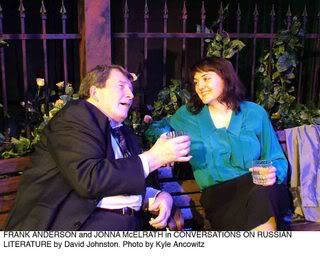 But one needs only a dim awareness of recent Russian history to appreciate this tense, funny production, just as one doesn't need to be familiar with the works of Turgenev, Bulgakov, or Chekhov, all of which are referenced as these two unforgettable characters probe for each others' soft spots. While very intellectually and historically aware, this play stands on its own merits.
But one needs only a dim awareness of recent Russian history to appreciate this tense, funny production, just as one doesn't need to be familiar with the works of Turgenev, Bulgakov, or Chekhov, all of which are referenced as these two unforgettable characters probe for each others' soft spots. While very intellectually and historically aware, this play stands on its own merits.
The evening begins, however, with a playlet for which some knowledge of Russian theater (specifically Chekhov) is needed. But the cheap jokes and spirited performances in Play Russia aren't enough to make it more than very modestly amusing even as an in-joke. As a piece of meta-theater, it's no The Actor's Nightmare. Fortunately, the play is short, and the two works that follow it are better. In the swiftly paced, slightly experimental For Those Of Us Who Have Lived In France, two historical figures and one stereotypical middle-American housewife explain why they wish they could go to France and are sad they can't. David Lapkin's impression of Henry Kissinger is particularly amusing.
Johnston's mastery of the link between humor and pathos becomes seriously clear in Mothra is Waiting.  A nightclub sister act has gotten old, to the point where drag queens are parodying it. One sister is ready to grab her last chance for a better life, while the other insists — screechingly — on waiting for the giant moth of the title to come and take her back to the island where the sisters once reigned as princesses. (Familiarity with classic Japanese monster movies is recommended!) It's a finely wrought absurdist miniature that leads us to expect much of the longer play that follows intermission. We are not disappointed. Don't miss this highlight of the winter season down on lower, lower Broadway.
A nightclub sister act has gotten old, to the point where drag queens are parodying it. One sister is ready to grab her last chance for a better life, while the other insists — screechingly — on waiting for the giant moth of the title to come and take her back to the island where the sisters once reigned as princesses. (Familiarity with classic Japanese monster movies is recommended!) It's a finely wrought absurdist miniature that leads us to expect much of the longer play that follows intermission. We are not disappointed. Don't miss this highlight of the winter season down on lower, lower Broadway.
Conversations on Russian Literature Plus Three More Plays by David Johnston continues through Saturday, March 7, with performances Wednesday through Saturday at 8:00 PM. Performances are at the Access Theater (380 Broadway, just north of White Street). Tickets are $18 ($10 during previews) and are available by calling SmartTix at 212-868-4444, or online.
No Place Like Home: Digging New York
Dorothy was right. There really is no place like home.
I’ve been to some of the great capitals of Europe — London, Paris, Copenhagen, Madrid. I’ve been to Jerusalem, the ancient spiritual home of three great religions. I’ve been to beautiful and fascinating old towns like Toledo (Spain), Copenhagen, Heidelberg, Montreal. Yet my own town, New York City, in whose suburbs I grew up and in which I now spend almost every day of my life, remains more deeply and endlessly fascinating to me than any of them.
You’d think it would become old and tired, boring and same-old. But it doesn’t. And I think I’ve figured out why.
The great cities and historic towns I’ve visited, especially in what we used to quaintly call the “Old World,” tend to have a powerful dedication to their pasts, avidly preserving their monuments. Roman ruins, medieval castles, royal palaces and estates, historic sites and neighborhoods are all right there for locals to take pride in and tourists to ogle. The great metropolises may spread out and become super-cities, but their “old town” neighborhoods remain.
New York, on the other hand, is constantly being torn down and rebuilt. Its 400-year history is there, but you have to dig for it, literally or in museums and books. You have to push aside the heavy crust of present-day culture, commerce, and architecture to reach the lower layers of the past. Otherwise, you could walk the city for days and see precious little that predates the 20th century. So many ancestors settled here when they came through Ellis Island, there is a lot of history on these streets, and nowadays people want to reconnect with that history once again by using websites like Genealogy Bank to look back and find their family tree to see where their ancestors went after arriving here, as well as what they are doing now.
New York has been a center of commerce for its whole history. Before landfill extended lower Manhattan several blocks into the rivers that frame it to the east and west, Wall Street ended at Water Street, at the river’s edge, and here stood the Meal Market.  But grains weren’t the only commodities sold here – the Meal Market was also the Slave Market.
But grains weren’t the only commodities sold here – the Meal Market was also the Slave Market.
Few of us think about the heavy presence of slaves in our city’s history. In fact, slavery wasn’t completely abolished in New York until 1827. A major exhibit at the New-York Historical Society helped educate a lot of us about that a few years ago. But how many Wall Street wizards – many of them now walking the streets looking for work, but hardly in danger of being sold at auction – think about the evil trade that was conducted at that very spot for two centuries?
Less than a mile to the north, in a section of lower Manhattan not frequented by tourists, a smallish square of concrete called Collect Pond Park sits ringed by tall, cold-shouldered buildings. Centuries ago, there was an actual pond here, fed by an underground spring that still runs somewhere deep beneath the streets. (The name “Collect” is a bastardization of a Dutch word – nothing was “collected” there.) The pond was a major source of fresh water for New Amsterdam and early New York. You’d never imagine that now.  Now it’s owned by pigeons, pecking in puddles.
Now it’s owned by pigeons, pecking in puddles.
Nearby was the Negro Burial Ground. In 1741, some 30 men, mostly African slaves, were executed – some hanged, others burned at the stake – during a witchhunt-like panic after a rash of suspicious fires. Some of the bodies were strung up and left to rot on an island in the Collect, a warning to other slaves not to participate in any further uprisings.
Today, you could live or work in this neighborhood your whole life and never know about the grisly things that happened here in those days.
By the 1800s the Collect had become a cesspool of industrial waste, so it was filled in with land taken from a hill that used to rise nearby. (We New Yorkers happily obliterate our geography along with our history.) The notorious Five Points neighborhood then evolved beside what used to be the Collect.
The book and movie Gangs of New York and the novel A Winter’s Tale both made good use of legends of the Five Points, but the average New Yorker can easily be forgiven for failing to make a connection between those tales and this actual part of town.  You have to read up on its history to find out just where the Five Points neighborhood actually was, and when you go there, it’s practically impossible to imagine it. Almost nothing remains of the history, the culture, even the buildings that defined the area in the time of Bill the Butcher and Jacob Riis. Now it’s just another part of Chinatown.
You have to read up on its history to find out just where the Five Points neighborhood actually was, and when you go there, it’s practically impossible to imagine it. Almost nothing remains of the history, the culture, even the buildings that defined the area in the time of Bill the Butcher and Jacob Riis. Now it’s just another part of Chinatown.
Good riddance to the Five Points, of course. It was a neighborhood of poverty, brutal crime, and terrible odors. But wouldn’t it be great if we could still walk those streets and picture what once was? We can’t. The very layout has changed. And this is characteristic of New York as a whole. Blink and it’s gone, replaced by something new – maybe something better, but too often not. A shame? Yes. Having bulldozed so many of our monuments and buried so much of our history, we’ve lost much.
But at the same time we have, in a sense, created something: we’ve made the city into one giant archeological site – a physical one, and also fertile ground for a kind of archeology of the mind. Precisely because we can no longer visit so many of the sites our history teaches us about, we are prodded to dig further, even if it’s only to read a book, watch a documentary, or go on a walking tour. Take an organized walking tour in New York and chances are you’ll find as many locals as visitors.
Sure, there are plenty of New Yorkers who breeze blithely through their day paying no attention to what’s around them now, much less to what used to be there. But there are a good many of us who feel the tug of an endless fascination with our city, who have a persistent need to dig, who insist on blowing away the dust and sniffing out the layers of history that underlie the pavement we walk on every day.
As the saying goes, home is where the heart is. But for us New Yorkers, home is also where the best stuff is. And a lot of that stuff is down below, buried deep in the past. It calls out to the curious souls walking above, beckoning us to plunge a spade down through the centuries.

